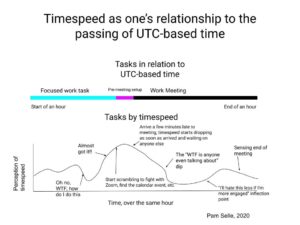

The speed of time
source link: https://thewebivore.com/the-speed-of-time/
Go to the source link to view the article. You can view the picture content, updated content and better typesetting reading experience. If the link is broken, please click the button below to view the snapshot at that time.
One interpretation of time might be that it’s a communal delusion that we can count things so fleeting as moments. If we “tell time” by a clock, we’re actually discussing the oscillation of a crystal, or referencing a value determined the global standard UTC.
“She says isn’t it funny how every second, every minute, every day, month, year, is accounted for, capable of being named—when time, or life, is so unwieldy, so intangible and slippery? This makes her feel compassion toward the people who invented the concept of “telling time.” How hopeful, she says. How beautifully futile. How perfectly human.”
If measured time is, perhaps, a garbage illusion we buy into because it makes things easier to reason about (this statement probably applies to a lot of things), then if I toss it away, there’s no such thing as constant time. Time does not move constantly, and thus has variable speeds. This speed, my “timespeed”, is determined by my relationship to the passing of “time” as we as a society have agreed to it, and my own perception of how it feels, and is a little more interesting to me than how fast grains of sand pass through an hourglass.
I shall attempt to illustrate this in a series of charts. In a given hour, let’s say I spend the first half of the hour working on a focused work task (such as programming). I find it mostly engaging, but sometimes it’s a slog. At half-past the hour, I have a meeting scheduled for the rest of the hour. I spend a few minutes before the meeting finding the meeting link, fighting with Zoom and peripheral equipment, etc.
(click the image for a full-size graphic)This is about how a work hour feels to me. The speed of time drastically increases when I am in “flow” on the task, and also when I am fighting with everything to attempt to make it to the meeting on time (in this case, as sometimes happens, I did not make it and am 1-2 minutes late. Timespeed for people in a meeting for others is very slow, so there’s a sharp dip). During the meeting, if I get lost and don’t know what’s happening, the timespeed is low (slow). If I’m more engaged (see: the deciding-to-be-more-engaged inflection point) it speeds up a bit. Sensing the end of the meeting slows things down again.
If timespeed/speed of time is something we’ll buy into, what if we try and influence it? In the example above, I increase my timespeed when I consciously decide to be more engaged — it makes the timespeed more comfortable (if I prefer a medium-range timespeed). Some other methods I think might influence perceived relationship of time, outside of the context of a work hour:
To slow down time (“time is going slowly”):
- Intense hiking or physical activity
- Smoking weed
- Attempting to do nothing at all (ex. sitting meditation)
- Try to work on something audacious (big projects, especially involving other people)
To speed up time (“time is going quickly”):
- Attempt to be somewhere “on time”
- Care for children, watching them grow
- Hang out with people you love
- Reflect on the passing of time, which can have an effect of compressing past time
“The days are long but the years are short”
Recommend
About Joyk
Aggregate valuable and interesting links.
Joyk means Joy of geeK
